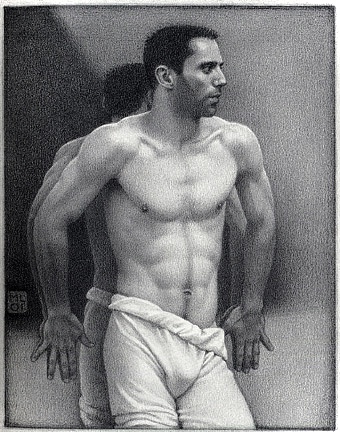Michael Leonard
Born 1933
British School
Against the Glass, 2001
Graphite pencil on paper.
Signed with initials and dated at front, bottom left corner ML 01
9 1/4 x 7 3/8 inches
Britain’s leading photorealist painter, Michael Leonard, is accomplished in many genres. Born in India in 1933 to British parents, he moved to England after the war and enrolled in St Martin’s School of Art, where he studied Commercial Design and Illustration. By the time of his graduation in 1957, he was already earning a living as a freelance illustrator, producing artwork for books, magazines, advertising and the press. Feeling “the need to express a more personal vision, and to make pictures for the wall rather than the page,” he began to turn his talents to fine art.
An accomplished portraitist, Leonard was commissioned to fashion the likenesses of such eminent personalities as Lincoln Kirstein, Edward Lucie-Smith and Adrian Ward Jackson. In 1985, Reader’s Digest commissioned him to paint a portrait of Queen Elizabeth with one of her beloved Corgis, in celebration of her sixtieth birthday. The canvas now hangs in the permanent collection of the National Portrait Gallery, London.
The nude, particularly the male nude, has been a recurring theme in Leonard’s work. His figures are usually on the move or in a state of transition, but even when they are at rest, dynamism is provided by the design of his compositions. Almost all his paintings of the nude are based on drawings which, besides being preparatory studies, are ends in themselves.
The present pencil drawing, crafted with Leonard’s virtuoso technique, is a case in point. His luminous play of light and dark recalls the tenebrism of the Dutch and Flemish masters. Modeled with rhythmic patterns of light and shadow, his drawing Against the Glass is precisely rendered, yet the figure is seemingly relaxed and spontaneous. The folds of the subject’s garment conceal, but also heighten, aspects of his form.
Leonard’s compositions, tasteful and sensual, depict protagonists who are going about their business and are unaware that they are being observed. This felicitous convention allows the viewer to contemplate the beauty of the artist’s models at a distance, at leisure and in complete discretion. Leonard seeks to instill in his nudes “a sense of dynamism and animal grace” and also “an observed reality” that “is underpinned by abstract values.”
Michael Leonard’s graphite drawings are prized by collectors for their compositional complexity, faultless draftsmanship, quiescent atmosphere, spiritual content, and a mysterious alchemy which transforms and exalts the seemingly commonplace, and which holds us spellbound.
Reference: the artist’s website, michaelleonardartist.com.
A25

